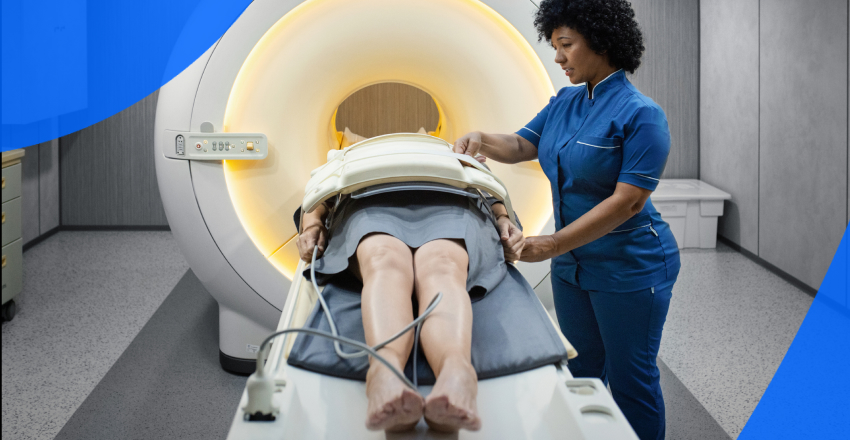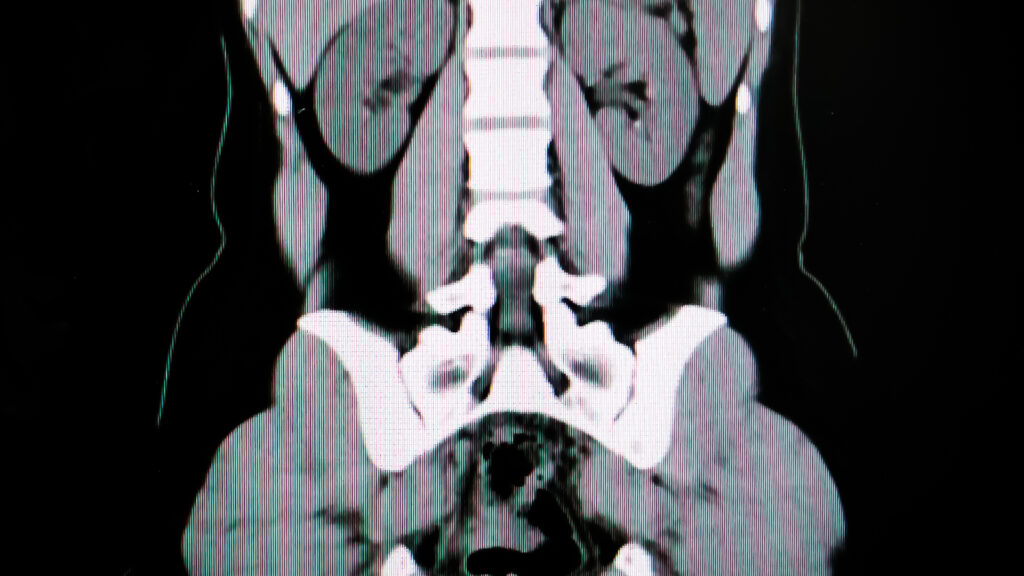
According to the American Cancer Society, roughly 84,000 new cases of bladder cancer will be diagnosed in 2025 throughout the United States. This disease affects patients assigned male at birth (AMAB) more frequently than patients assigned female at birth (AFAB). This article provides a brief overview of the disease, outlines symptoms and variants and focuses on detection and diagnostic techniques.
Bladder cancer is caused by cancerous cells within the bladder growing and spreading out of control. These cells may form tumors or growths and affect organ function if the disease becomes advanced.
The bladder is part of the urinary system, which helps rid the body of toxins and waste. Other parts of the urinary system include the two kidneys, two ureters and the urethra. The kidneys filter waste products from the blood, forming urine. Urine then travels from the kidneys to the bladder through tubes called ureters. From there, it is stored in the bladder and leaves the body during urination.
Because the bladder is such an integral part of the urinary system, bladder cancer symptoms often affect this process. While earlier stages of the disease may not cause any symptoms, some common ones to be aware of include:
It is important to remember that experiencing these symptoms does not necessarily mean you have bladder cancer. Many benign medical conditions can cause similar symptoms, such as kidney stones or urinary tract infections. It is recommended that you speak with your medical provider about any concerns or symptoms you experience so they can provide their professional opinion and offer appropriate next steps.
There are multiple types of bladder cancer, which may affect treatment decisions and other medical recommendations. Here are some types to be aware of:
Besides the types just covered, bladder cancer can also be categorized based on whether it has spread past the bladder’s muscle wall:

Abdominal CT scan of the urinary system.
There are multiple medical tests, imaging scans and procedures that go into a bladder cancer diagnosis. Here is an overview of the most common methods used.
The physical examination may include questions about personal and family medical histories, discussion of possible symptoms and addressing any related concerns.
AMAB patients may undergo a digital rectal exam, in which the doctor inserts a gloved finger into the rectum to check for abnormalities such as a possible bladder tumor. AFAB patients may undergo a pelvic exam for similar reasons. Usually, a physical examination is just a starting point for diagnosis or to help rule out other potential illnesses.
It is very common for a urine sample to be collected for laboratory analysis. Because bladder cancer shares many symptoms with benign urinary conditions, a urinalysis can be helpful to check for signs of a urinary tract infection, blood or other substances. While urinalysis alone cannot confirm or rule out bladder cancer, urine samples can be used for the following tests:
A cystoscopy is a very common procedure when trying to determine if a patient has bladder cancer. A thin, tube-like device called a cystoscope is carefully inserted through the patient’s urethra and into the bladder. It contains a tiny camera, light and tools that allow the physician to look for growths, tumors or abnormalities. This also allows the provider to collect biopsy samples or remove very small tumors, if needed.
Computed tomography scans use X-ray technology to create highly detailed internal images for study. Unlike traditional X-rays, which typically capture only 2 to 4 images, CT scans collect numerous pictures (called “slices”) and compile them into a detailed cross-sectional image that can better show soft tissues, bones and blood vessels.
For bladder cancer, a CT scan can help detect tumors, growths, inflammation and other abnormalities. It can also assess nearby lymph nodes and other parts of the urinary system, and help determine whether any cancer has spread to distant areas of the body. To better differentiate the areas being scanned, patients are often given a contrast dye through an I.V., which improves visibility for the doctor analyzing the scans. CT scans can also help guide biopsy needles if a tissue sample is needed for testing.
Magnetic resonance imaging is a technique that uses strong magnets and radio waves to create highly detailed internal images. A contrast dye may be used to better differentiate tissues and organs when necessary. MRIs are especially helpful in determining whether bladder cancer has spread to nearby lymph nodes or other areas of the body.
An ultrasound scan uses high-frequency sound waves to create internal images of the body. These waves bounce off tissues, bones and other internal structures, echoing back in real time to form an image that can be captured and saved for study. Ultrasound scans are used to assess the bladder, determine whether nearby tissues and organs (such as the kidneys) are affected and guide a biopsy needle in real time when collecting a sample.
IVP is a type of X-ray scan used to examine the urinary tract, including the ureters, kidneys and bladder. A contrast agent is administered, and X-rays are taken at specific intervals as the dye moves through the kidneys, ureters and into the bladder. This can help show how well the urinary system is functioning and identify signs of cancer, such as tumors. That said, this test is not as commonly performed today, as other imaging methods, such as CT scans, are considered equally effective.
A TURBT is typically performed after a bladder tumor or growth has been confirmed through imaging or cystoscopy. While a cystoscopy can remove small bladder tumors, a TURBT is used to remove larger ones or take a biopsy sample, which is then sent to a laboratory for analysis.
A surgical tool called a resectoscope is inserted through the urethra and into the bladder. It has a small, electrified loop of wire at the end that allows the surgeon to remove tumors and cauterize blood vessels to prevent excessive bleeding. The tumor is then analyzed in a laboratory for cancer cells, which helps determine the stage of the cancer and other details vital to treatment decisions.
This method is an effective way to diagnose bladder cancer and can also serve as part of the treatment for early-stage cancer that has not spread beyond the bladder lining.
Your imaging results are interpreted by a radiologist—an expert in medical imaging—who carefully reviews your scans and provides a detailed report of any findings. This report is then sent to your referring physician, who, with a deeper understanding of your medical history and past exams, can offer further insights and recommendations on next steps in a follow-up appointment.
Turnaround times for imaging results can vary widely depending on the facility and your doctor’s availability. Often, patients wait a week or more and receive their results during a follow-up appointment. With PocketHealth, your imaging results are securely accessible as soon as they’re approved for release by the hospital or imaging clinic. This allows you the opportunity to review your results and prepare questions ahead of your follow-up visit.
To help you understand your bladder imaging results, PocketHealth provides clear definitions and illustrations for complex medical terms—plus an in-depth explanation of your full imaging report. This is paired with highlights of key anatomy in your imaging to help you better comprehend what you’re looking at.
Here are some frequently asked questions regarding bladder cancer.
Bladder cancer staging can get a bit complex, but at a basic level, it’s a method used to categorize where the cancer cells have spread within the body. A more detailed explanation of bladder cancer stages can be found here. For our purposes, here is a simplified version of the different bladder cancer stages:
Currently, there are no bladder cancer screening recommendations for patients at average risk. However, if a patient has a personal or family history of the disease, they may want to discuss preventative screenings with their physician. Possible screening methods could include various urinalysis tests or imaging, if deemed necessary. Because there is no official standard, recommendations are likely to vary by patient and physician. If you have concerns or are at higher risk for the disease, it may be helpful to talk with your doctor about screening options.
While there are several possible bladder cancer risk factors, it is important to remember that these factors often do not lead to cancer. Still, being aware of them can be helpful, especially since some can be reduced or improved through lifestyle choices or behavior changes. Here are some current risk factors, according to the National Cancer Institute:
How aggressive bladder cancer is will often vary on an individual basis. The type, stage and spread of the disease all play a major role in treatment options and outcomes, as does the patient’s underlying health and other individualized factors. It is important to discuss your personal case with your physician to gain more accurate information, as many factors influence the aggressiveness and prognosis of the disease.
Bladder cancer that is localized to the bladder alone is easier to treat than cases that have metastasized to other areas of the body. However, treatments continue to advance and improve, offering hope for better outcomes despite these factors.
Bladder cancer often has a good prognosis depending on the cancer type, stage of the disease and other relevant factors. According to the National Cancer Institute, current 5-year survival rates for bladder cancers are:
It is important to remember that every patient and case is different, and that prognosis information, while helpful, may not be accurate for every individual. The data used for survival statistics come from large groups of patients who may have had very different treatments and health histories.
When caught early, many bladder cancer cases have a high cure rate, especially if they are non-muscle invasive. The 5-year survival rate for some types of bladder cancer that have not spread beyond the inner layer of the bladder is as high as 97%.
Bladder cancer is generally detected through a combination of physical exams, medical imaging, urinary testing and diagnostic procedures. These may include an intravenous pyelogram, cystoscopy or transurethral resection of a bladder tumor (TURBT). The removed tissue is then tested for cancer cells. In the early stages, a TURBT may also be used to treat bladder cancer.
Getting a bladder cancer diagnosis can feel overwhelming. It may be helpful to remember that you’re not alone, and you may find that cancer support groups and qualified therapists can help you navigate this situation. Your doctor will likely have local information and resources you can take advantage of. Meanwhile, here are some online resources you may find helpful:
PocketHealth makes it simple to keep track of your medical imaging results. All of your images and reports are permanently available in one secure location and can be accessed online—anytime, anywhere. Reports can also be easily shared with other members of your care team, if needed. When used in conjunction with your medical provider’s professional advice, it is a powerful tool to better understand your imaging results.
PocketHealth also provides personalized health insights based on the findings in your report to help you stay on top of any next steps. This includes clearly surfacing any follow-up actions found in your report and generating customized questions to ask your doctor so you can make the most of your follow-up appointment.
While a bladder cancer diagnosis may feel overwhelming, better understanding your results and working closely with your healthcare team can give you the best chance of managing your condition and protecting your health.
Published: August 20, 2025
Trusted by more than 800+ hospitals and clinics.











